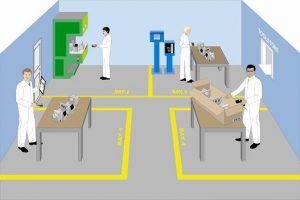Work in Process Solutions: The success of many businesses comes down to accountability and efficiency. Every manufacturing or maintenance and repair organization (MRO) is faced with similar challenges to job and work order status tracking – lost orders, incorrect builds and delays are all typical results of an inferior tracking system. Having a robust Work in Process (WIP) system in place will help you meet compliance mandates, be prepared for any potential recalls or issues and increase efficiency to provide better customer service.
With the right WIP software and scanning hardware, you can provide your business with the means to track vital manufacturing data in real-time. Improve build accuracy and reduce labour costs by providing your employees with all the information they need with no paperwork and less procedural steps. Start making more strategic decisions based on the status of every phase of your production process. The Key Benefits of JBS Work In Process System?
Our Work In Process System provides the cost-saving benefits of:
What is Work In Process?
Work in process (WIP) is a common tracking function found at any manufacturing facility as well as repair centers to manage items as they move throughout a facility. The core concern behind a WIP system is making sure you have the ability to collect and track specific details of each stage in your production process. With the use of barcodes and scanning technology, a system will reduce unnecessary steps while providing an accurate view of the state of everything in your facility.
In a WIP system, each item is tracked uniquely as it is fabricated, manufactured or processed in some way. Normally, there are several steps to the process the item goes through, each with a set of data that will have to be captured. At each stage of the process the item will be scanned and whatever actions are done to it will be recorded. This chain of scans and data provide a very accurate trail of the item’s existence from assembly to a finished product. With this information, you also have a line of accountability when there are defects or production issues.
Each business will have specific points of interest they will want to track but in general, you will be collecting data related to:
Along the way, you would use barcodes to identify items and even processes for quick and accurate data entry. It is very common to utilize scanning to track employee IDs, processes, machines or tools used and part numbers of raw materials. Scanning a barcode is much faster and drastically more accurate than having employees manually enter data into the system. Most WIP systems will be tracking everything in real-time, on a network and will use different scanning devices that best fit their situation. Whether you have fixed terminals with basic gun scanners that are wired to the network or mobile computers roaming freely, having the network infrastructure that can manage your data and number of users is instrumental for an effective system.
Regardless of the number of steps or complexity, a well-suited WIP system provides a degree of accuracy and detail into your process that will allow for the growth of your business through greater efficiency and tighter control over your processes. What should you address when making a Work In Process System? When putting together an effective and suitable work in process system there are a few key questions to answer:

